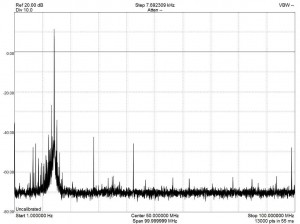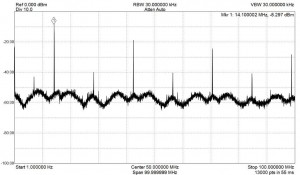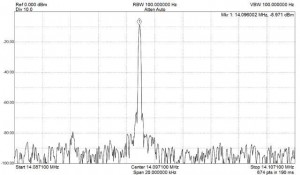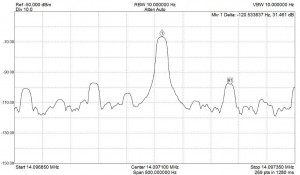[Updated Dec 25 -- corrections and clarifications] WSPR is the ham radio “Weak Signal Propagation Reporter” system (http://wsprnet.org/). Here is my recent experience using a Raspberry Pi as a very simple stand-alone WSPR transmitter. 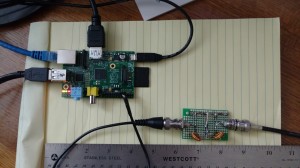
Shown above is a Raspberry Pi Model B, going through a four-pole 14MHz bandpass filter, and then to a multiband dipole strung through the trees. It transmits on approximately 14.0971 MHz, at a power of +10 dBm (0.01 Watt).
Raspberry Pi Versions and code compatability
There are several Raspberry Pi versions. I first tried using my new Raspberry Pi B+
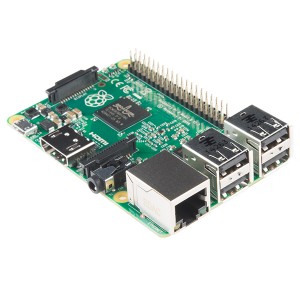
I used this code: https://github.com/8cH9azbsFifZ/WsprryPi, which had been referenced by several people who had used the RPi for WSPR. It didn’t work on this version of the Raspberry Pi, and by inserting debugging “printf” statements could see that it was getting hung up when using DMA (a type of memory access). A bit of Googling found that this was a known problem, but the program would run on the older RPi. I tried it on my older Raspberry Pi-B, and it worked!
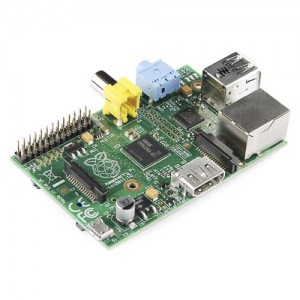
Here is the raw Pi output between 0-100 MHz : 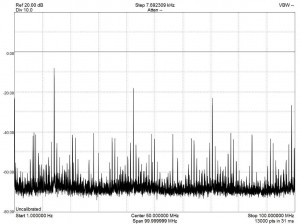
I used a capacitively-coupled -20dB pad for this measurement. You don’t want to put a resistive 50-Ohm load on the RPi output, so I used a 0.1uF DC-blocking capacitor. Notice all the spurs being generated by the Raspberry Pi. We see the typical strong odd-harmonics that we would expect from the squarewave output of the Pi, and weaker even-order harmonics since the output isn’t a pure squarewave (rise and fall times probably aren’t identical.) There are also other spurious signals, -32dBc (dB below the carrier). These are presumably sampling artifacts, caused because we are effectively sampling a 14 MHz squarewave with the internally-generated 250 MHz clock driving the Pi divider. More on this later… So the RPi output is a bit too dirty to put on the air. I’ve seen people use a Pi-network low-pass filter for this, but because there are lower-frequency spurs as well as harmonics, I decided to use a simple band-pass filter:
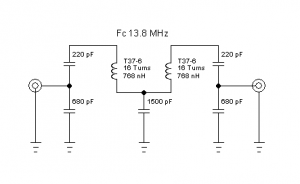
Note that the inductor values are calculated, not measured. I wound them using #28 enameled wire on a T37-6 toroid core from Amidon. This filter has a capacitive divider input and output so there is no issue with DC loading the RPi output. Here is the filter response: 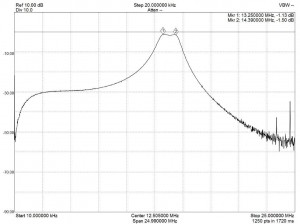
I have it a bit overcoupled to simplify tuning, so I lose a few dB at the 14.0971 MHz operating frequency. If I get ambitious I might optimize it, but it works well enough for now. Here is the RPi output after the filter:
You can see that there are still some close-in spurs that my simple filter isn’t going to take care of: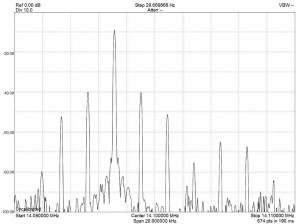
Still, the spurs are about 30dB below the 10mw carrier, so I decided it was good enough and put it on the air.
But what about the Raspberry Pi 2 B+???
This code still wouldn’t run on the newer RPi 2 B+. After a bit of searching I found this code update which had fixed the hardware dependencies that broke things on the new Pi: https://github.com/JamesP6000/WsprryPi In addition, this version has more command-line options that are very useful for debugging and running WSPR. I tried it first on the older RPi-B.
WOW! What happened to the spurs???
The output was dramatically different with this new code. Look below and notice how most of the non-harmonic spurious signals have disappeared! We now have the fundamental, strong odd harmonics, weaker even harmonics, a few (presumably) sampling artifacts, and a wideband, low-level noise floor around -50dBc (I used a peak-hold setting to capture the worst-case noise-floor envelope):
Running it through my band-pass filter we get a really nice signal: 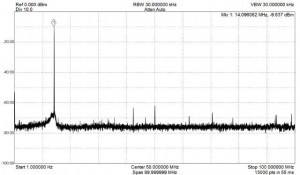
Zooming in we see a very clean carrier with just a hint of close-in noise:
Zooming in further we see what look like 60 and 120 Hz sidebands, presumably coming from the cheap wall-wart USB charger I am using to power the RPi.
Why does this new code generate a cleaner output, seeing that the hardware is identical? I need to compare the two versions, but I suspect that the difference is in the choice of divisors and the configuration of the MASH noise-shaping. Here’s a link to the RPi divider hardware that covers some of the details of operation (see section 6.3): https://www.raspberrypi.org/wp-content/uploads/2012/02/BCM2835-ARM-Peripherals.pdf
I will report back in a few weeks when I get a chance to dig further into this. I haven’t even tried this on the new RPi 2 B+, but I will soon. Until then, the RPi WSPR transmitter is running full-time from my Friday Harbor location: The signal was being received so well by some friends in Sonoma County that I put the 20dB attenuator back in between the Pi and the filter, reducing the output to -10dBm (100 micro-Watts). The signal was still received at a distance of 1121 km, giving us about 11 million kilometers per Watt! I have since resumed transmitting at +10dBm.
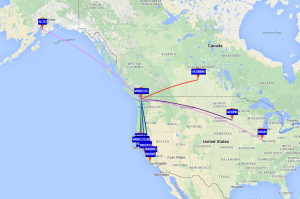
More details to come: I will be writing about these topics sooner or later:
- Links to other WSPR / Pi articles
- Frequency stability with the tiny low-cost Raspberry Pi oscillator
- WSPR timing accuracy using Network Time Server
- GPS time and frequency (?) synchronization
- Hardware connections
- Remote control of Raspberry Pi over the internet
- Operation on other frequencies
- Analysis of Raspberry Pi frequency generation, especially spectral purity and noise-shaping
- Trying the new RPi-Zero (the $5 model!)
Use This Code: WsprryPi code that runs on all (?) Raspberry Pi boards: https://github.com/JamesP6000/WsprryPi
